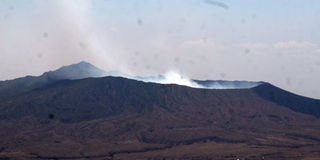State, private firm strike deal to develop geothermal plant

PHOTO | FILE Smoke billows from Mount Longonot, a dormant volcano in the Great Rift Valley that rises 2,776 metres above sea level, in this 2009 picture. Africa Geothermal International Kenya will develop a 140 megawatt power project in the area.
What you need to know:
- Kenya Power enters into a 25-year agreement with Africa Geothermal International Kenya to build a 140MW electricity project in Longonot
The government’s efforts to attract private investors in geothermal production is starting to pay off after Kenya Power inked a 25-year power purchase deal with a firm to construct a 140MW plant in Longonot.
Africa Geothermal International Kenya (AGIL) will develop the 140 megwatt power project through an arrangement of develop, construct, own, and operate while Kenya Power is obligated to purchase the power generated.
Kenya Power managing director Joseph Njoroge said the agreement with AGIL is an important step in meeting the nation’s energy demands.
“Geothermal, unlike other renewable energy sources such as wind, solar, and hydroelectric, is not dependent on weather. The initial capital is expensive but power is cheaper in the long run,” said Mr Njoroge.
Currently, geothermal sources account for about 15 per cent of Kenya’s power generation mix. Experts give estimates of 6GW or more along the whole African Rift.
According to projections for power production in Kenya, nearly half of the national power output is expected to come from geothermal sources by 2018 in a strategic shift from hydro-power, which has increasing become unreliable because of erratic rainfall.
In Kenya, hydro-power sources mainly concentrated at the Seven Forks Dam are almost exhausted, leaving space for only small plants in other parts of the country.
The geothermal power deal is among recent milestones in an endeavour to increase power production from the estimated 7,000MW to 10,000MW geothermal source concentrated in Rift Valley that puts Kenya among the top states with such a resource in the world.
The government formed the Geothermal Development Authority with the objective of absorbing upfront costs associated with site studies and other costs that have discouraged many private sector players from investing in geothermal power production.
It has also bought two rigs which are hired out to private companies undertaking drilling.
The private investors initially insisted on sovereign guarantees before undertaking such projects to cushion themselves from losses in case they hit dry wells.
The Olkaria fields are the first in Africa where geothermal steam has been utilised for electricity generation and is estimated to have a potential of over 1,000MW.
The current installed capacity is about 209MW, with another 240MW power development in progress at Olkaria I and IV that is due for commissioning this year and a further 50MW at Olkaria III, expected to be commissioned in 2014.
The Geothermal Development Company (GDC) has completed drilling wells in Menengai while others are in progress, putting an additional 10MW on the national grid.
The 140MW power plant’s commercial operation date is scheduled for 2018 and the development and construction activities will be carried out in the interim period. AGIL has performed all the surface exploration required and drilling is expected to commence in early 2014.
Kenya is among a few countries with huge untapped geothermal power, with 14 sites in the Rift Valley that have an estimated potential of between 7,000MW and 10,000MW. The country is behind top geothermal power producers like America, at 2,544MW, Philippines 1,931MW, Indonesia 799MW, and Italy 790MW.
Earn carbon credits
The Olkaria fields are expected to contribute 700MW and Menengai 560MW when fully developed.
According to estimates, increased production will reduce over-reliance on hydro-power, which currently contributes nearly half of the national power production.
By 2018, hydro is expected to contribute 28 per cent in the power mix while thermal will provide 18 per cent.
The country also expects to earn carbon credits from use of geothermal, which is considered clean energy that is also sustainable.




